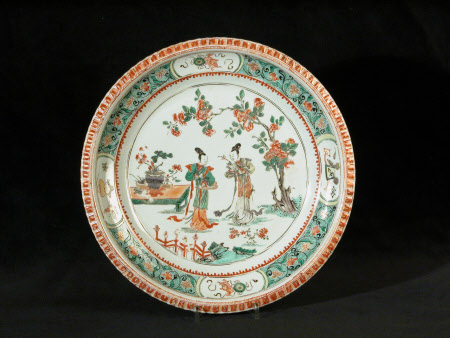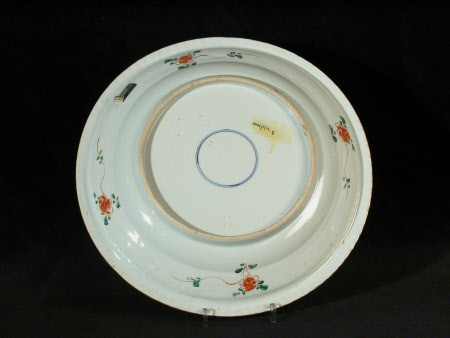Serving dish
Category
Ceramics
Date
circa 1695 - circa 1710
Materials
Porcelain decorated with enamels and gold
Measurements
330 mm (Dia)
Place of origin
Jingdezhen
Order this imageCollection
Shugborough Estate, Staffordshire
NT 1270511.2.2
Summary
A round serving dish, one of a set of three, the second of four sizes, part of a partial 16-piece Chinese tableware service, porcelain, after French metalware shapes, with gadrooned edges (sometimes erroneously described as “pie-crust”), and painted in translucent green, red, yellow, aubergine and black enamels and gold, a palette known as ‘wucai’ (five colours) in China or ‘famille-verte’ (green family) in the West a term used since the 1860s, depicting two women in court dress in a garden tending a table filled with ornamental pot plants, and one holding a branch possibly a scented osmanthus or cassia flower, within a seeded Europeanized foliate scroll band on a seeded ground, with panels filled with antique and Buddhist symbols, the reverse with two concentric rings in underglaze blue, and four groups of flowering branches in green and red enamel, China, Jingdezhen, circa 1695-1710.
Full description
A round serving dish, one of a set of three, the second of four sizes, part of a partial 16-piece Chinese tableware service, porcelain, after French metalware shapes, with gadrooned edges (sometimes erroneously described as “pie-crust”), and painted in translucent green, red, yellow, aubergine and black enamels and gold, a palette known as ‘wucai’ (five colours) in China or ‘famille-verte’ (green family) in the West a term used since the 1860s, depicting two women in court dress in a garden tending a table filled with ornamental pot plants, and one holding a branch possibly a scented osmanthus or cassia flower, within a seeded Europeanized foliate scroll band on a seeded ground, with panels filled with antique and Buddhist symbols, the reverse with two concentric rings in underglaze blue, and four groups of flowering branches in green and red enamel, China, Jingdezhen, circa 1695-1710. This dish is part of an assembled 25-piece Chinese export service. The shapes, primarily round and octagonal, have ‘gadrooned’ rims, a narrow band of complex moulding, after European metalware forms on silver and pewter, but also found on French faïence and soft-paste porcelain at Rouen or St. Cloud, and Dutch Delft. In order to finance Louis XIV’s ruinous military campaigns, sumptuary decrees were passed in 1689 and 1709, ordering courtiers to have their plate melted down. They replaced it with ceramic tablewares from Rouen of China. This provided a new demand for luxury ceramic tablewares, as it became unpatriotic to eat off precious metal. They were painted in an enamelling workshop on blanks, the octagonal wares have underglaze blue concentric rings added before glazing and firing. The decoration depicts elegant female courtiers in palace activities, tending potted plants on a terrace, playing the qin, a stringed instrument perhaps from a literary source, and elsewhere on oblong octagonal dishes there are scenes of lotus gathering. other patterns are known with birds and flowers The seeded-green borders have auspicious emblems in the cartouches. The service, with additional plates made by Miles Mason, circa 1806-13, has been at Shugborough since at least the early 19th century, when some of it was sold in the 1842 auction, as lot 37, ‘Part of a dinner service of splendid Oriental china, green and red border with Chinese figures consisting of 23 large octagon shaped dishes, 1 circular ditto and 24 plates all to correspond,’ which sold for £21.0.0, along with lot 29 ‘Six octagon shaped ornamental dishes rich flowered pattern of green, red and gold’ and lot 30 ‘six to correspond.’ It is possible that the service may have been part of the famous Spanish prize acquired at sea by Admiral Anson in 1743, belonging to a Spanish official returning home to Spain with household goods acquired in China. There was Spanish plate and coins also from the prize at Shugborough. Alternatively it may have been purchased by Anson second-hand in London, if not inherited. (Information supplied by Patricia Ferguson - March 2013).
Provenance
Possibly acquired by Commodore George Anson (1697 – 1762) in 1743.
Marks and inscriptions
Base of dish: Historic NT Inventory Number: Shug/C/16, g Underside edge of dish: Black/silver NT asset number label

